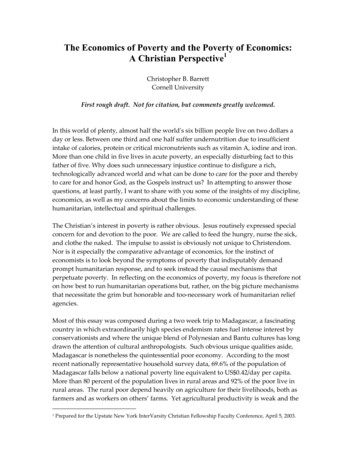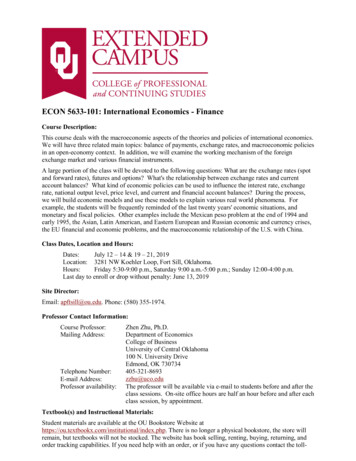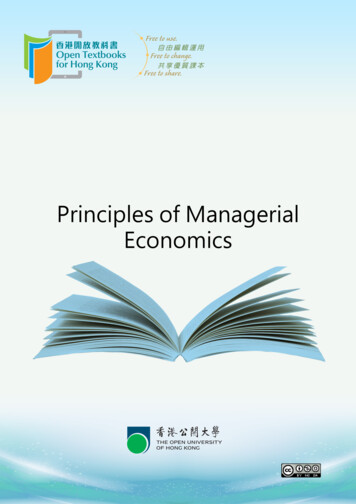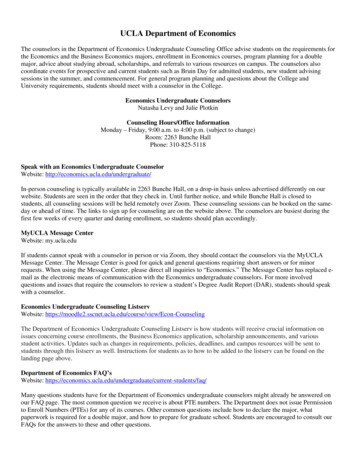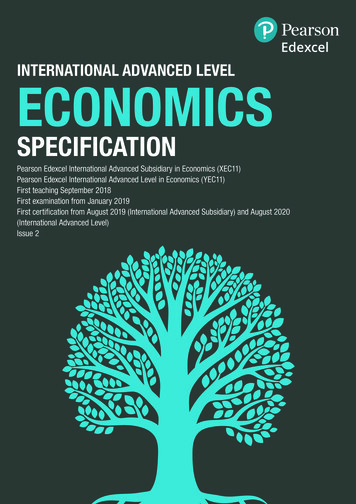
Transcription
INTERNATIONAL ADVANCED LEVELEDEXCEL INTERNATIONAL excel International GCSE in Economics (9-1) (4ET0)Pearson Edexcel International Advanced Subsidiary in Economics (XEC11)First examination JunePearson Edexcel International Advanced Level in Economics (YEC11)First teaching September 2018First examination from January 2019First certification from August 2019 (International Advanced Subsidiary) and August 2020(International Advanced Level)Issue 2
Edexcel, BTEC and LCCI qualificationsEdexcel, BTEC and LCCI qualifications are awarded by Pearson, the UK’s largest awardingbody offering academic and vocational qualifications that are globally recognised andbenchmarked. For further information, please visit our qualification website atqualifications.pearson.com. Alternatively, you can get in touch with us using the details onour contact us page at qualifications.pearson.com/contactusAbout PearsonPearson is the world's leading learning company, with 35,000 employees in more than70 countries working to help people of all ages to make measurable progress in their livesthrough learning. We put the learner at the centre of everything we do, because whereverlearning flourishes, so do people. Find out more about how we can help you and yourlearners at qualifications.pearson.comAcknowledgementsThis specification has been produced by Pearson on the basis of consultation with teachers,examiners, consultants and other interested parties. Pearson would like to thank all thosewho contributed their time and expertise to the specification’s development.References to third party material made in this specification are made in good faith. Pearsondoes not endorse, approve or accept responsibility for the content of materials, which maybe subject to change, or any opinions expressed therein. (Material may include textbooks,journals, magazines and other publications and websites.)All information in this specification is correct at time of going to publication.ISBN 978 1 446 94954 2All the material in this publication is copyright Pearson Education Limited 2018
Summary of International Advanced Subsidiary/AdvancedLevel Economics specification Issue 2 changesSummary of changes made between previous issue and thiscurrent issuePagenumberContent overview for Unit 3 has been changed from ‘Measures of economicperformance’ into ‘Types and sizes of businesses’.10, 32The title of Appendix 6 has been amended.68Quantitative skill 6 ‘Calculate total revenue has been added to the IAStable in Appendix 7.69If you need further information on these changes or what they mean, contact us via ourwebsite at: tml.
ContentsAbout this specification2Why choose Edexcel qualifications?4Why choose Pearson Edexcel International AdvancedSubsidiary/Advanced Level qualifications in Economics5Qualification at a glance8Economics content11Unit 1: Markets in action12Unit 2: Macroeconomic performance and policy22Unit 3: Business behaviour31Unit 4: Developments in the global economy39Assessment information50Administration and general information53Entries and resitting of units53Access arrangements, reasonable adjustments, specialconsideration and malpractice53Awarding and reporting55Student recruitment and progression57Appendices59Appendix 1: Codes60Appendix 2: Pearson World Class Qualification design principles61Appendix 3: Transferable skills63Appendix 4: Level 3 Extended Project qualification65Appendix 5: Glossary67Appendix 6: Command word taxonomy68Appendix 7: Quantitative skills69Appendix 8: Use of calculators70
About this specificationThe Pearson Edexcel International Advanced Subsidiary in Economics and the PearsonEdexcel International Advanced Level in Economics are part of a suite of InternationalAdvanced Level qualifications offered by Pearson.These qualifications are not accredited or regulated by any UK regulatory body.Key featuresThis specification includes the following key features.StructureThe Pearson Edexcel International Advanced Subsidiary in Economics and the PearsonEdexcel International Advanced Level in Economics are modular qualifications.The Advanced Subsidiary can be claimed on completion of the International AdvancedSubsidiary (IAS) units.The International Advanced Level can be claimed on completion of all the units(IAS and IA2 units).ContentThese qualifications build on the content covered in the legacy (2013) Pearson EdexcelInternational Advanced Level in Economics. They have been updated to align them withrecent changes in the equivalent AS and A Level qualifications taken in England and Wales.AssessmentThe qualifications are assessed through examination only.Specification updatesThis specification is Issue 2 and is valid for first teaching from September 2018. If there areany significant changes to the specification, we will inform centres in writing. Changes willalso be posted on our website.For more information please visit qualifications.pearson.com2Pearson Edexcel International Advanced Subsidiary/Advanced Level in Economics –Specification – Issue 2 – June 2018 Pearson Education Limited 2018
Using this specificationThis specification gives teachers guidance and encourages effective delivery of thesequalifications. The following information will help you get the most out of the content andguidance.Compulsory content: as a minimum, all the bullet points in the content must be taught.The word ‘including’ in content specifies the detail of what must be covered.Assessments: teachers should deliver these qualifications using a good range of examplesto support the assessment of the content.Depth and breadth of content: teachers should use the full range of content and all theassessment objectives given in the subject content section.Qualification aims and objectivesThe aims and objectives of these qualifications are to enable students to: develop an interest in, and enthusiasm for, the subject appreciate the contribution of economics to the understanding of the wider economic andsocial environment develop an understanding of a range of concepts and an ability to use those concepts in avariety of different contexts use an enquiring, critical and thoughtful approach to the study of economics and developan ability to think as an economist understand that economic behaviour can be studied from a range of perspectives develop analytical and quantitative skills, together with qualities and attitudes that willequip them for the challenges, opportunities and responsibilities of adult and working life.Qualification abbreviations used in this specificationThe following abbreviations appear in this specification: International Advanced Subsidiary – IAS International A2 – IA2 (the additional content required for an IAL) International Advanced Level – IAL.Pearson Edexcel International Advanced Subsidiary/Advanced Level in Economics –Specification – Issue 2 – June 2018 Pearson Education Limited 20183
Why choose Edexcel qualifications?Pearson – the world’s largest education companyEdexcel academic qualifications are from Pearson, the UK’s largest awarding organisation.With over 3.4 million students studying our academic and vocational qualificationsworldwide, we offer internationally recognised qualifications to schools, colleges andemployers globally.Pearson is recognised as the world’s largest education company, allowing us to driveinnovation and provide comprehensive support for Edexcel students to acquire theknowledge and skills they need for progression in study, work and life.A heritage you can trustThe background to Pearson becoming the UK’s largest awarding organisation began in 1836,when a royal charter gave the University of London its first powers to conduct exams andconfer degrees on its students. With over 150 years of international education experience,Edexcel qualifications have a firm academic foundation, built on the traditions and rigourassociated with Britain’s educational system.To find out more about our Edexcel heritage please visit our ut-pearson/our-historyResults you can trustPearson’s leading online marking technology has been shown to produce exceptionallyreliable results, demonstrating that at every stage, Edexcel qualifications maintain thehighest standards.Developed to Pearson’s world-class qualifications standardsPearson’s world-class standards mean that all Edexcel qualifications are developed to berigorous, demanding, inclusive and empowering. We work collaboratively with a panel ofeducational thought-leaders and assessment experts to ensure that Edexcel qualificationsare globally relevant, represent world-class best practice and maintain a consistentstandard.For more information on the world-class qualification process and principles please go toAppendix 2: Pearson World Class Qualification design principles or visit our 4Pearson Edexcel International Advanced Subsidiary/Advanced Level in Economics –Specification – Issue 2 – June 2018 Pearson Education Limited 2018
Why choose Pearson Edexcel InternationalAdvanced Subsidiary/Advanced Level qualificationsin EconomicsWe have listened to feedback from all parts of the international school subject community,including a large number of teachers. We have made changes that will engage internationallearners and give them skills that will support their progression to further study ofEconomics and to a wide range of other subjects.Key qualification features: Development of quantitative skills – students develop these skills throughout thecontent of the course and are required to apply these skills to relevant economic contextswithin the assessment. Consistent command word taxonomy – we have reduced the number of commandwords used in the assessment and applied a consistent mark tariff. Clear and simple structure - based on your feedback we have taken the opportunity tomake some improvements to the clarity and structure of our new specification. Accessible assessment – to ensure all students are able to access the whole exampaper we have introduced ramping within each question. Questions start with a low marktariff and become more challenging as students work their way through the paper,helping to build confidence. Engaging content – Content allows students to develop an awareness of trends in theglobal economy, researching developed and developing economics, including a focus oncontemporary issues. Clear and straightforward question papers – our question papers are clear andaccessible for students of all ability ranges. Our mark schemes are straightforward so thatthe assessment requirements are clear. Increased level of support – textbook, online digital resources, mapping documents,scheme of work, getting started guide and training.Broad and deep development of learners’ skills – we designed the InternationalAdvanced Level qualifications to extend learners’ knowledge by broadening and deepeningskills, for example learners will: read sources to interpret and evaluate economic information write extended responses respond appropriately to a range of question types, including multiple-choice,short-answer, data response and open-ended questions develop an understanding of economic concepts and apply these concepts to real-lifesituations.Pearson Edexcel International Advanced Subsidiary/Advanced Level in Economics –Specification – Issue 2 – June 2018 Pearson Education Limited 20185
Progression – International Advanced Level qualifications enable successful progression onto further study and the workplace. Through our world-class qualification developmentprocess we have consulted with higher education representatives to validate theappropriateness of these qualifications, including content, skills and assessment structure.Related qualifications – Our International Advanced Level in Economics sits within ourwider subject offer for Business and Economics qualifications. We also offer: Pearson Edexcel International Advanced Level in Business Pearson Edexcel International Advanced Level in Accounting Pearson Edexcel Level 3 Advanced Subsidiary GCE in Business Pearson Edexcel Level 3 Advanced GCE in Business Pearson Edexcel Level 3 Advanced Subsidiary GCE in Economics A Pearson Edexcel Level 3 Advanced GCE in Economics A Pearson Edexcel Level 3 Advanced Subsidiary GCE in Economics B Pearson Edexcel Level 3 Advanced GCE in Economics B BTEC Nationals and Higher Nationals in Business.More information can be found on our website (qualifications.pearson.com) on the EdexcelInternational Advanced Level pages.6Pearson Edexcel International Advanced Subsidiary/Advanced Level in Economics –Specification – Issue 2 – June 2018 Pearson Education Limited 2018
Supporting you in planning and implementingthese qualificationsPlanning Our Getting Started Guide gives you an overview of the Pearson Edexcel InternationalAdvanced Subsidiary/Advanced Level in Economics to help you understand the changes tocontent and assessment, and what these changes mean for you and your students. We will provide you with an editable course planner and scheme of work. Our mapping documents highlight key differences from the legacy qualification.Teaching and learning Our skills maps will highlight opportunities for students to develop skills that areassessed, as well as skills that are not directly assessed. Print and digital learning and teaching resources – promote any time, any place learningto improve student motivation and encourage new ways of working.Preparing for examsWe will also provide a range of resources to help you prepare your students for theassessments, including: examiner commentaries following each examination series.ResultsPlusResultsPlus provides the most detailed analysis available of your students’ examinationperformance. It can help you identify the topics and skills where further learning wouldbenefit your students.examWizardA free online resource designed to support students and teachers with examinationpreparation and assessment.Training eventsIn addition to online training, we host a series of training events each year for teachers todeepen their understanding of our qualifications.Get help and supportOur subject advisor service will ensure that you receive help and guidance from us. You cansign up to receive qualification updates and product service news atqualifications.pearson.com or email ‘sign me up’ to TeachingEconomics@pearson.com.Pearson Edexcel International Advanced Subsidiary/Advanced Level in Economics –Specification – Issue 2 – June 2018 Pearson Education Limited 20187
Qualification at a glanceQualification overviewPearson Edexcel International Advanced Subsidiary in EconomicsThis qualification consists of two externally-examined units.The International Advanced Subsidiary is the first half of the International Advanced Levelqualification and consists of two IAS units, Units 1 and 2. This qualification may be awardedas a discrete qualification or may contribute 50 per cent towards the International AdvancedLevel qualification.Pearson Edexcel International Advanced Level in EconomicsThis qualification consists of four externally-examined units.The International Advanced Level consists of the two IAS units (Units 1 and 2) plus two IA2units (Units 3 and 4). Students wishing to take the International Advanced Level must,therefore, complete all four units.Course of studyThe structure of these qualifications allows teachers to construct a course of study that canbe taught and assessed as either: distinct modules of teaching and learning with related units of assessment taken atappropriate stages during the course; or a linear course assessed in its entirety at the end.8Pearson Edexcel International Advanced Subsidiary/Advanced Level in Economics –Specification – Issue 2 – June 2018 Pearson Education Limited 2018
Content and assessment overviewIASUnit 1: Markets in actionExternally assessedWritten examination: 1 hour and 45 minutesAvailability: January, June and October*Unit code:WEC11/0150% ofthe totalIAS25% ofthe totalIALFirst assessment: January 201980 marksContent overview Introductory concepts Consumer behaviour and demand Supply Price determination Market failure Government intervention in marketsAssessment overviewSection A: Six multiple-choice questions (6 marks).Section B: Five short-answer questions (20 marks).Section C: A five-part question, based on data provided in a source booklet (34 marks).Section D: One 20-mark essay question from a choice of two (20 marks).IASUnit 2: Macroeconomic performance and policyExternally assessedWritten examination: 1 hour and 45 minutesAvailability: January, June and October*Unit code:WEC12/0150% ofthe totalIAS25% ofthe totalIALFirst assessment: June 201980 marksContent overview Measures of economic performance Aggregate demand (AD) Aggregate supply (AS) National income Economic growth Macroeconomic objectives and policiesAssessment overviewSection A: Six multiple-choice questions (6 marks).Section B: Five short-answer questions (20 marks).Section C: A five-part question, based on data provided in a source booklet (34 marks).Section D: One 20-mark essay question from a choice of two (20 marks).Pearson Edexcel International Advanced Subsidiary/Advanced Level in Economics –Specification – Issue 2 – June 2018 Pearson Education Limited 20189
IA2*Unit code:WEC13/01Unit 3: Business behaviourExternally assessedWritten examination: 2 hoursAvailability: January, June and October50% ofthe totalIA225% ofthe totalIALFirst assessment: January 202080 marksContent overview Types and sizes of businesses Revenue, costs and profits Market structures and contestability Labour markets Government interventionAssessment overviewSection A: Six multiple-choice questions (6 marks).Section B: A five-part question, based on data provided in a source booklet (34 marks).Section C: Two 20-mark essay questions from a choice of three (40 marks).IA2Unit 4: Developments in the global economyExternally assessedWritten examination: 2 hoursAvailability: January, June and October*Unit code:WEC14/0150% ofthe totalIA225% ofthe totalIALFirst assessment: June 202080 marksContent overview Causes and effects of globalisation Trade and the global economy Balance of payments, exchange rates and international competitiveness Poverty and inequality The role of the state in the macroeconomy Growth and development in developing, emerging and developed economiesAssessment overviewSection A: Six multiple-choice questions (6 marks).Section B: A five-part question, based on data provided in a source booklet (34 marks).Section C: Two 20-mark essay questions from a choice of three (40 marks).*See Appendix 1: Codes for a description of this code and all other codes relevant to thesequalifications.10Pearson Edexcel International Advanced Subsidiary/Advanced Level in Economics –Specification – Issue 2 – June 2018 Pearson Education Limited 2018
Economics contentUnit 1: Markets in action12Unit 2: Macroeconomic performance and policy22Unit 3: Business behaviour31Unit 4: Developments in the global economy39Pearson Edexcel International Advanced Subsidiary/Advanced Level in Economics –Specification – Issue 2 – June 2018 Pearson Education Limited 201811
Unit 1: Markets in actionIAS compulsory unitExternally assessed1.1 Unit descriptionThis unit gives students an introduction to the nature of economicsand examines how the price mechanism allocates resources inlocal, national and global markets.Students will learn to apply supply and demand analysis toreal-world situations, and will be able to suggest reasons forconsumer behaviour. This will involve looking at how consumersact in a rational way to maximise utility and how firms maximiseprofit but also why consumers may not behave rationally.Students will analyse the nature and causes of market failure andunderstand the strengths and weaknesses of possible policyremedies.Students will need to be able to apply relevant quantitative skillsto the content covered in this unit, including calculations, the useof data and the drawing of diagrams. A full list of quantitativeskills can be found in Appendix 7: Quantitative skills.1.2 Assessment information First assessment: January 2019. The examination lasts 1 hour and 45 minutes. The paper is out of 80 marks. The paper will include, multiple-choice, short-open responseand extended-writing questions. Some of these will relate tosources provided in a Source booklet. The paper will include questions that target quantitative skills.This may include making and interpreting calculations, anddrawing and interpreting diagrams. Calculators may be used in the examination. See Appendix 8 formore information.12Pearson Edexcel International Advanced Subsidiary/Advanced Level in Economics –Specification – Issue 2 – June 2018 Pearson Education Limited 2018
1.3 Unit content1.3.1 Introductory conceptsWhat students need to learn:1 The nature ofeconomicsa) Economics as a social science: inability to conduct scientificexperiments.b) The development of models in economics based on assumptions.c) The use of the ceteris paribus assumption in building models anddrawing conclusions based on them.2 Positive andnormativeeconomicsa) The distinction between positive statements and valuejudgements on economic issues.3 Scarcitya) The problem of unlimited wants and finite resources.b) The role of value judgements in influencing economic decisionmaking and policy.b) The distinction between renewable and non-renewableresources.c) The link between scarcity and opportunity cost.d) The distinction between free goods and economic goods.4 Productionpossibilityfrontiersa) The use of production possibility frontiers to depict: the maximum productive potential of an economyefficient or inefficient allocation of resourcespossible and unobtainable productionopportunity cost (using marginal analysis)economic growth and decline.b) The distinction between movements along, and shifts in,production possibility frontiers, and their possible causes.c) The distinction between capital goods and consumer goods.d) The significance of capital goods for productivity and economicgrowth.5 Specialisation andthe role of moneyand financialmarketsa) The advantages and disadvantages of specialisation and thedivision of labour in organising production; Adam Smith’s viewson the division of labour.b) The function of money as a medium of exchange, a measure andstore of value, and a method of deferred payment; thesignificance of these functions for specialisation.c) The role of financial markets: tototototofacilitate savingmake funds available to businesses and individualsfacilitate the exchange of goods and servicesprovide forward markets in commodities and currenciesprovide a market for equities.Pearson Edexcel International Advanced Subsidiary/Advanced Level in Economics –Specification – Issue 2 – June 2018 Pearson Education Limited 201813
1.3.1 Introductory concepts (continued)What students need to learn:6 Free market,mixed andcommandeconomiesa) The distinction between free market, mixed and commandeconomies.b) The advantages and disadvantages of free market and commandeconomies.c) The role of the state in a mixed economy.14Pearson Edexcel International Advanced Subsidiary/Advanced Level in Economics –Specification – Issue 2 – June 2018 Pearson Education Limited 2018
1.3.2 Consumer behaviour and demandWhat students need to learn:1 Rationaldecision makinga) The assumption of rationality in decision making: consumers aimto maximise utility by making rational choices; firms aim tomaximise profits.b) Reasons why consumers may not aim to maximise utility: 2 The demand curvethe influence of other people’s behaviour (herding)habitual behaviourinertiapoor computational skillsthe need to feel valuedframing and bias.a) The concept of ‘demand’.b) The distinction between movements along a demand curve andshifts of a demand curve.c) The concept of diminishing marginal utility and its significancefor the shape of the individual demand curve.d) Factors that may cause a shift in the demand curve: 3 Price, income andcross-elasticitiesof demandchanges in the price of substitutes or complementary goodschanges in real incomechanges in tasteschanges in size and age distribution of the populationadvertising.a) The concepts of ‘price’, ‘income’ and ‘cross-elasticities ofdemand’.b) How to use formulae to calculate price, income andcross-elasticities of demand.c) Interpretation of numerical values of price elasticity of demand: perfectly price elastic demandprice elastic demandunitary price elastic demandprice inelastic demandperfectly price inelastic demand.d) The factors influencing price elasticity of demand: availability of substitutesbrandingpercentage of total expenditureaddictiveness of productdurability of product.e) How to calculate total revenue.f) How price elasticity of demand varies along a straight linedemand curve.Pearson Edexcel International Advanced Subsidiary/Advanced Level in Economics –Specification – Issue 2 – June 2018 Pearson Education Limited 201815
1.3.2 Consumer behaviour and demand (continued)What students need to learn:3 Price, income andcross-elasticitiesof demand(continued)g) The relationship between price elasticity of demand and totalrevenue.h) Interpretation of numerical values of income elasticity ofdemand: perfectly income elastic demandincome elastic demandincome inelastic demandperfectly income inelastic demandthe distinction between normal goods and inferior goods.i) Interpretation of numerical values of cross elasticity of demand.Significance for the degree to which goods are: substitutes complements unrelated.j) The significance of price, income and cross-elasticities of demandfor firms, consumers and the government.16Pearson Edexcel International Advanced Subsidiary/Advanced Level in Economics –Specification – Issue 2 – June 2018 Pearson Education Limited 2018
1.3.3 SupplyWhat students need to learn:1 The supply curvea) The concept of ‘supply’.b) The distinction between movements along a supply curve andshifts of a supply curve.c) Factors that may cause a shift in the supply curve: 2 Price elasticity ofsupplychanges in the costs of productionthe introduction of new technologyindirect taxes (specific and ad valorem)government subsidiesnatural disasters.a) The concept of ‘price elasticity of supply’.b) Calculation and interpretation of numerical values of priceelasticity of supply: perfectly elastic supplyelastic supplyunitary elastic supplyinelastic supplyperfectly inelastic supply.c) Factors that influence price elasticity of supply: the time periodavailability of stock/perishabilitymobility of factors of productionlegal constraintscapacity.d) The distinction between the short run and long run in economicsand its significance for price elasticity of supply.Pearson Edexcel International Advanced Subsidiary/Advanced Level in Economics –Specification – Issue 2 – June 2018 Pearson Education Limited 201817
1.3.4 Price determinationWhat students need to learn:1 Determination ofmarketequilibriuma) Equilibrium price and quantity, and how they are determined.b) Causes of changes in the equilibrium price and quantity as aresult of shifts in demand and supply curves.c) The operation of market forces to eliminate excess demand andexcess supply.2 Consumer andproducer surplusa) The distinction between consumer and producer surplus.3 Functions of theprice mechanisma) The rationing, incentive and signalling functions of the pricemechanism for allocating scarce resources.b) How changes in demand or supply might affect consumer andproducer surplus.b) The price mechanism in the context of different types ofmarkets, including local, national and global markets.4 Indirect taxes andsubsidiesa) The impact of indirect taxes on consumers, producers and thegovernment.b) The incidence of indirect taxes on consumers and producers.c) The impact of subsidies on consumers, producers and thegovernment.d) The incidence of subsidies on consumers and producers.18Pearson Edexcel International Advanced Subsidiary/Advanced Level in Economics –Specification – Issue 2 – June 2018 Pearson Education Limited 2018
1.3.5 Market failureWhat students need to learn:1 Sources of marketfailurea) Why market failure occurs: too much or too little of a good isproduced and/or consumed compared to the socially optimallevel of output.b) Sources of market failure: 2 Positive andnegativeexternalitiesexternalitiesthe free-rider problem; non-provision of public goodsimperfect market informationmoral hazardspeculation and market bubbles.a) The distinction between private benefits, external benefits andsocial benefits.b) The distinction between private costs, external costs and socialcosts.c) The distinction between: externalexternalexternalexternalbenefits of productionbenefits of consumptioncosts of productioncosts of consumption.d) The use of diagrams, using marginal analysis, to illustrate: the external benefits from consumption the external costs from production the distinction between the market and social optimumpositions; identification of the welfare loss or gain areas.e) The impact of externalities in various contexts: 3 Non-provision ofpublic a) The distinction between public and private goods: private goods: rival and excludable public goods: non-rival and non-excludable.b) Why public goods may not be provided by the private sectormaking reference to the free-rider problem.4 Imperfect marketinformationa) The distinction between symmetric and asymmetric information.b) The significance of information gaps.c) How imperfect market informatio
Pearson Edexcel International Advanced Subsidiary in Economics (XEC11) Pearson Edexcel International Advanced Level in Economics (YEC11) First teaching September 2018 . – textbook





